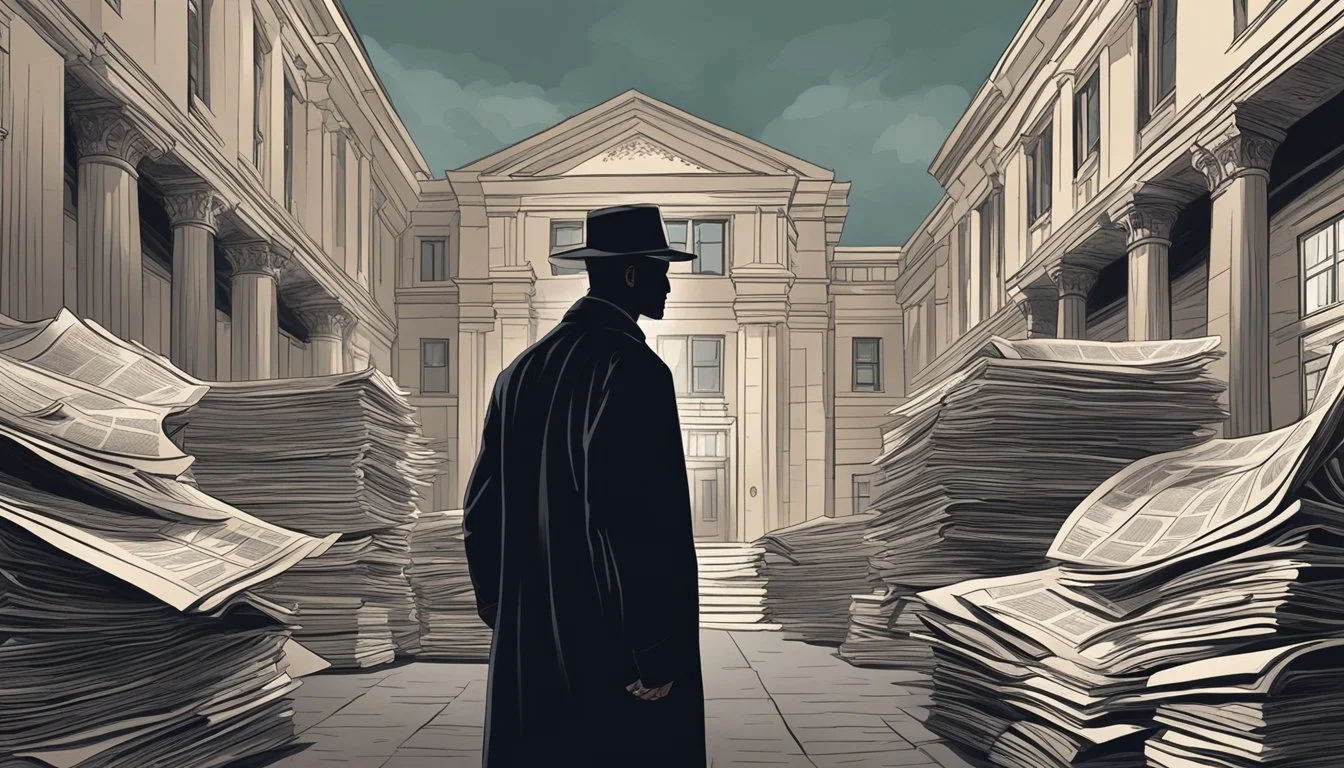The Monster of Florence by Douglas Preston and Mario Spezi: Unraveling Italy's Most Infamous Serial Killer Case
Douglas Preston's move to Florence, Italy, sparked an unexpected journey into one of the country's most chilling criminal cases. Upon arriving in his new Tuscan home, Preston learned that the nearby olive grove had been the site of gruesome double murders committed by the notorious "Monster of Florence." Intrigued by this dark history, Preston teamed up with Italian journalist Mario Spezi to investigate the unsolved case.
"The Monster of Florence" by Douglas Preston and Mario Spezi is a gripping nonfiction account of Italy's most infamous serial killer. The book delves into the series of brutal murders that terrorized Florence between 1968 and 1985, targeting couples in secluded areas. Preston and Spezi's collaboration brings together years of research, interviews, and firsthand experiences in their pursuit of the truth.
The authors' investigation takes unexpected turns as they become entangled in the ongoing case. Their relentless quest for answers leads them to examine various suspects, confront corrupt officials, and challenge long-held theories about the killer's identity. Through their meticulous work, Preston and Spezi shed new light on this haunting mystery that has captivated Italy for decades.
Authors and Background
Douglas Preston and Mario Spezi brought unique perspectives to their investigation of the Monster of Florence case. Their backgrounds and experiences shaped their approach to uncovering the truth behind the infamous murders.
Douglas Preston's Involvement
Douglas Preston, an American author of fiction and non-fiction, moved to Florence, Italy with his family in 2000. He became intrigued by the Monster of Florence case due to its proximity to his new home. Preston's curiosity led him to delve deeper into the unsolved murders that had terrorized the Tuscan countryside.
His background in writing thrillers and true crime stories equipped him with the skills to analyze the complex case. Preston's outsider perspective allowed him to approach the investigation with fresh eyes, unconstrained by local biases or preconceptions.
Mario Spezi's Perspective
Mario Spezi, an Italian journalist, had been covering the Monster of Florence case for decades. His extensive knowledge and connections made him an invaluable resource for understanding the intricacies of the investigation.
Spezi's years of reporting on the murders gave him unique insights into the various theories and suspects. He had interviewed key witnesses, examined evidence, and developed his own hypotheses about the killer's identity.
His deep involvement in the case sometimes put him at odds with law enforcement. Spezi's unwavering pursuit of the truth eventually led to his own legal troubles.
Collaboration Process
Preston and Spezi's partnership began when Preston sought out the experienced journalist for information on the case. Their collaboration combined Preston's fresh perspective with Spezi's in-depth knowledge.
The authors worked together to review evidence, conduct interviews, and piece together a comprehensive narrative of the murders. They challenged official theories and explored alternative possibilities.
Their investigation took unexpected turns, leading them to identify a potential suspect and even conduct an interview with him. The collaboration ultimately resulted in their book, "The Monster of Florence," which presented their findings and experiences to a global audience.
Historical Context
Italy's 20th-century history and criminal landscape provide crucial context for understanding the Monster of Florence case. The events unfolded against a backdrop of social change, political turmoil, and evolving law enforcement practices in post-war Italy.
Italy in the 20th Century
Italy experienced significant transformations in the 20th century. After World War II, the country transitioned from fascism to democracy. The 1950s and 1960s saw rapid economic growth, urbanization, and modernization. This period, known as the "Italian Economic Miracle," brought prosperity but also social upheaval.
By the 1970s and 1980s, when the Monster of Florence murders occurred, Italy faced political instability and economic challenges. The "Years of Lead" saw increased political violence and terrorism. These factors strained law enforcement resources and public trust in institutions.
Italian History and Crime
Crime in Italy has deep historical roots, often intertwined with regional identities. The Tuscany region, including Florence, has a rich cultural heritage but also a history of infamous figures and criminal activities.
Organized crime groups like the Sicilian Mafia, Neapolitan Camorra, and 'Ndrangheta have long influenced Italian society. However, the Monster of Florence case stood out as a rare example of a serial killer in modern Italian history.
The Florentine hills, where many of the murders took place, became synonymous with fear and mystery. This case challenged traditional notions of crime in Italy, which typically focused on organized criminal networks rather than lone predators.
The Monster of Florence Case
The Monster of Florence terrorized Italy with a series of brutal murders between 1968 and 1985. This case shocked the public and baffled investigators for decades.
Serial Killings Overview
The Monster of Florence targeted couples in secluded areas around Florence, Italy. The killer struck 16 times over 17 years, claiming 16 victims in total.
Most attacks occurred on weekend nights. The perpetrator ambushed couples in parked cars or camping sites.
The long time span and seemingly random victim selection made the case especially challenging for police. Despite extensive investigations, the true identity of the Monster remains unknown.
Victims and Mutilation
The Monster's victims were young couples engaged in intimate acts. Both men and women were shot with the same .22 caliber gun.
Female victims suffered horrific post-mortem mutilations. The killer removed body parts as trophies.
This signature mutilation linked the crimes and sparked public terror. It also led to speculation about the killer's motives and psychological profile.
Investigators found no signs of robbery or sexual assault at crime scenes. This suggested the murders were motivated by other factors.
Investigation Milestones
1974: Police link earlier murders to the Monster case.
1981: Task force formed to catch the killer.
1985: Last known Monster attack occurs.
1994: Pietro Pacciani convicted but later acquitted.
2000s: New suspects emerge, including farm worker Antonio Vinci.
The investigation faced numerous setbacks. False leads, questionable evidence, and conspiracy theories complicated efforts to solve the case.
To this day, the true identity of the Monster of Florence remains one of Italy's most notorious unsolved mysteries.
Cultural Impact
Preston and Spezi's book sparked renewed interest in the Monster of Florence case, influencing media portrayals and public perceptions in Italy. It challenged existing narratives and conspiracy theories surrounding the murders.
Media Interpretation
The book inspired various adaptations and references in popular culture. A film based on Preston and Spezi's work was announced, with George Clooney initially attached to star and produce. The case also influenced Italian crime dramas and documentaries.
TV shows like "Hannibal" referenced the Monster of Florence, incorporating elements of the murders into their storylines. The book's popularity led to increased international coverage of the case in news outlets and true crime podcasts.
Public Perception in Italy
"The Monster of Florence" reignited public debate in Italy about the unresolved murders. It challenged official theories about Satanic cults and Mafia involvement, offering alternative explanations.
The book's publication sparked controversy among some Italian authorities. Some officials criticized Preston and Spezi's investigation, leading to legal troubles for Spezi.
Many Italians reconsidered long-held beliefs about the case. The book's exploration of police missteps and judicial overreach resonated with those skeptical of official accounts.
Florence's tourism industry saw increased interest in Monster-related sites. Some tour operators began offering "Monster of Florence" themed walks, highlighting locations connected to the murders.
Legal Proceedings and Controversies
The Monster of Florence case led to complex legal battles and widespread controversy. Multiple suspects were tried, but prosecutorial missteps and alleged cover-ups marred the investigations.
Court Trials and Key Figures
Pietro Pacciani, a farmer with a violent past, became the primary suspect in 1992. Prosecutors, led by Ruggero Perugini, built a case against him. Pacciani was convicted in 1994 but later acquitted on appeal in 1996.
Antonio Vinci, related to previous suspects, came under scrutiny. However, no charges were filed against him.
The Italian judicial system faced criticism for its handling of the case. Multiple theories and suspects emerged, but conclusive evidence remained elusive.
Missteps and Obstruction
Allegations of obstruction of justice plagued the investigations. Some officials were accused of protecting powerful individuals potentially connected to the crimes.
Crucial evidence disappeared or was mishandled. Key witnesses changed their testimonies, raising questions about the integrity of the process.
Prosecutors faced accusations of pursuing personal vendettas rather than following evidence. This led to public distrust in the judicial proceedings.
Aftermath of Judicial Outcomes
The case remains officially unsolved. Pacciani died in 1998, shortly before he was to be retried. His death was initially ruled a heart attack but later investigations suggested possible foul play.
Public frustration grew as years passed without resolution. The case became a symbol of judicial dysfunction in Italy.
Several books and documentaries have since explored the failures of the investigation. These works often highlight systemic issues within the Italian legal system.
Comparative Analysis
The Monster of Florence case shares similarities with other notorious serial killers, while also exhibiting unique characteristics in its modus operandi. This analysis explores the commonalities and distinguishing features of the Florentine crimes.
Similarities to Other Serial Killers
The Monster of Florence's pattern of targeting couples in isolated areas bears resemblance to the Zodiac Killer's attacks in California. Both killers operated over extended periods, evading capture and taunting authorities.
Like many serial killers, the Monster displayed a consistent victim type and method of attack. The use of the same weapon across multiple crimes is another shared trait among serial offenders.
The case generated intense public interest and media coverage, similar to other high-profile serial killer investigations. This attention often complicates police work and can lead to false leads or suspect theories.
Notable Differences in MO
The Monster of Florence's exclusive focus on couples engaged in intimate acts sets it apart from many other serial killer cases. This specific target selection suggests a possible sexual motive or obsession unique to the perpetrator.
Unlike some serial killers who take trophies, the Monster typically did not remove items from victims. The killer's precision in committing double murders without leaving substantial evidence also distinguishes these crimes.
The long gaps between attacks and the apparent cessation of crimes in 1985 differ from the escalating patterns often seen with serial killers. This inconsistency has led to theories of multiple perpetrators or a killer who left the area.
Modern-Day Reverberations
The Monster of Florence case continues to captivate audiences and inspire creative works. Its impact extends beyond Italy, influencing both fiction and ongoing investigations.
Influence on Fiction and Film
The chilling tale of the Monster of Florence has inspired numerous fictional adaptations. George Clooney acquired the film rights to Preston and Spezi's book, signaling Hollywood's interest in the case. The story's elements of mystery, corruption, and vengeance make it ripe for cinematic interpretation.
Several crime novels and thrillers have drawn inspiration from the case, incorporating elements of the Monster's modus operandi or the investigative complexities. These works often explore themes of obsession and the dark underbelly of seemingly idyllic locations.
Continued Interest and Research
The unsolved nature of the Monster of Florence case fuels ongoing research and speculation. Amateur sleuths and professional investigators continue to pore over case files, seeking new leads or reexamining old evidence.
Online forums and podcasts dedicated to the case have emerged, creating communities of true crime enthusiasts who discuss theories and share information. This sustained interest has led to new books and documentaries exploring different angles of the investigation.
The tragic fate of the young lovers targeted by the Monster remains a poignant aspect of the case, driving efforts to uncover the truth and seek justice for the victims decades later.
Ethical Considerations
The Monster of Florence raises important ethical questions about reporting on violent crimes and the responsibilities of true crime writers. These issues touch on the balance between public interest and sensitivity to victims.
Reporting on Violence
Journalists covering violent crimes face ethical dilemmas. They must decide how much graphic detail to include without sensationalizing violence. The Monster of Florence case involved brutal murders, posing challenges for responsible reporting.
Respecting victims' privacy is crucial. Reporters should avoid unnecessarily intrusive coverage of grieving families. At the same time, providing accurate information serves the public good by raising awareness.
Fact-checking is essential when covering ongoing investigations. Spreading unverified rumors can hinder police work and cause undue panic. Journalists should clearly distinguish between confirmed facts and unproven theories.
Responsibilities of True Crime Writers
True crime authors like Preston and Spezi have an obligation to thorough research and accuracy. They must verify sources and avoid speculation presented as fact. Ethical writers acknowledge the limitations of available evidence.
Humanizing victims is important. True crime should not reduce people to mere plot points. Writers can honor victims' memories by portraying them as complex individuals.
Addressing societal factors that contribute to crime adds valuable context. The Monster of Florence book examines cultural attitudes in Italy that impacted the investigation. This broader perspective enhances public understanding.
True crime writers should be transparent about their methods and sources. They should disclose any personal involvement in the case, as Preston and Spezi do regarding their own legal troubles during the investigation.
Impact on Digital Privacy and Policy
The Monster of Florence case raised important questions about digital privacy and data protection policies. As investigators pursued leads, they collected and analyzed large amounts of personal information about suspects and witnesses.
This practice highlighted the need for clear guidelines on how law enforcement can access and use digital data. It also sparked debates about balancing public safety with individual privacy rights.
The case occurred before the rise of social media and smartphones, but it foreshadowed many current digital privacy concerns. Today, companies like Facebook and Google collect vast amounts of personal data for advertising purposes.
Key privacy issues raised:
Data collection and retention by authorities
Access to private communications
Use of digital surveillance tools
Rights of suspects vs. public safety needs
These topics remain highly relevant in discussions of modern privacy policies and regulations. The Monster of Florence investigation serves as an early example of the complex challenges surrounding digital data and law enforcement.
Additional Entities
The Monster of Florence case involved several entities beyond the main investigators and suspects. Local law enforcement agencies played a crucial role in the investigation, including the Carabinieri and the Polizia di Stato.
Various prosecutors worked on the case over the years. Notably, Giuliano Mignini became involved and developed controversial theories about satanic cults.
The media had a significant impact on public perception. Newspapers like La Nazione, where Mario Spezi worked, reported extensively on the murders and investigation.
Forensic experts analyzed evidence from the crime scenes. Their findings and interpretations influenced the direction of the inquiry.
Several individuals were wrongly accused or investigated during the case. This included Pietro Pacciani, who was initially convicted but later acquitted on appeal.
Victims' families sought justice and closure throughout the prolonged investigation. Their experiences and perspectives add depth to the narrative.
The city of Florence itself became an entity in the story. Its history, culture, and atmosphere provided a backdrop to the crimes and subsequent investigation.








